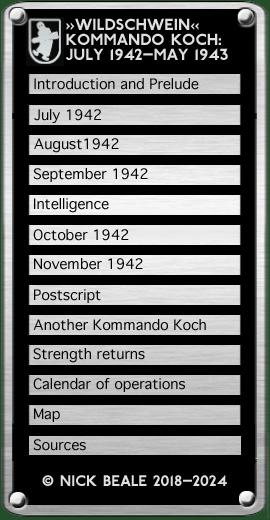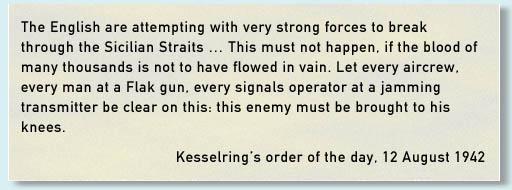|
The earliest contemporary reference I have so far found to Kommando Koch itself is from 1 August 1942 when Ob. Süd was allocating infra-red telescopes to Luftwaffe units. The purpose of this Nachtsuchgerät (night search device) was defensive: it would show heat sources—a night fighter’s exhaust for example—as a yellow or reddish spot of light, and three of them were issued to Kdo. Koch. Although this offers us a date by which the Kommando was in, or destined for, the Mediterranean Theatre, the unit is not readily identifiable in the (often incomplete and obscure) order of battle reports transmitted at that time. It was not until the 16th that Fliegerkorps X gave figures for two unnamed units—with 3 (0) and 3 (2) aircraft—one of which may have been the Kommando. Nachtsuchgerät … detects a night fighter … by mean of two telescopes [Gläser], each of length 18 cm and diameter 8 cm … The apparatus can in some cases be connected via an amplifier to a warning system, a modification known as "Armin" … Prisoners of war have indicated that each telescope is attached to a 2 millimetre cannon [sic] pointing rearward like a sight, so that the telescope “looks” in the same direction as the gun and has a field of view of 30º. AIr Ministry to RAF Middle East, 4 August 1942
Two Ju 88 carrying Caruso were operating on the night of 1/2 August, apparently in connection with an attack by aircraft of I./LG 1 on tanks and vehicles near El Alamein. At 2240 hours on the 3rd/4th, a lone Caruso-equipped Ju 88 operated in support of an Italian attack on Valetta, Malta. On 2 August an He 111, GJ+JH had been flown from Kalamaki to Heraklion, Crete; British monitors hearing its wireless traffic did not then know that it belonged to Kdo. Koch.
Whilst aircraft were escorting Axis convoys throughout that summer, the night of 4/5 August stands out as the first time (to British knowledge) that an He 111 of Kommando Koch was involved. It was in the air from 2025–0300 GMT and there were “strong indications that [it] operated against British recce aircraft near [an] Axis convoy”. Shortly afterwards it was learned that: One aircraft successfully carried out Wildschwein [wild boar] operation until both apparatus failed. It is impossible to be sure what “both apparatus” meant: two jamming sets, transmitter and monitoring receiver or some other permutation of electronics? Three nights later, a Heinkel was being used to map British visual and radio beacons in the Western Desert. When the Malta-bound Pedestal convoy was approaching the Sicilian Narrows on the 12th, Kesselring’s order of the day urged: The English are attempting with very strong forces to break through the Sicilian Straits … This must not happen, if the blood of many thousands is not to have flowed in vain. Let every aircrew, every man at a Flak gun, every signals operator at a jamming transmitter be clear on this: this enemy must be brought to his knees. At this time Air HQ Egypt was urging “the most rigid secrecy” on the subject of jamming, so that the enemy should learn nothing of its effectiveness. In Malta by 5 August five instances of airborne jamming had been detected and three from ground sources. Two days later the Malta Detachment of No. 89 Squadron summed up its experience: During the last month numerous cases have occurred of jamming of V.H.F. and A.I. equipment by enemy transmitters resulting in contact being lost with raiders … An attempt was made to overcome this interference by ensuring that every aircraft operating was equipped with A.I. capable of working on two different frequencies, so that with 3 aircraft at readiness, 6 different frequencies were obtainable. This method was in some measure successful, but it was decided that new equipment … A.I. Mark VII, be sent from England: at present the enemy has no way of interfering with operation of this equipment … Initially difficulties were encountered when operating this equipment at heights in excess of 10,000 feet [3,000 m] but these have since been remedied. The reader should bear in mind that while this new radar might circumvent one aspect of the German disruption, ground radars and VHF communications were still vulnerable, so a means of homing on the jamming aircraft themselves was still needed.
During August jamming transmissions from Noto continued but the “signals plane KG 54” seems to have been used less often: after operating for 45 minutes on the night of 2/3 August (in parallel with a KG 77 Caruso-Ju 88) it was not active again until the 8/9th. In the interim, one Caruso-Ju 88 attacked Valetta each night, at the same time as the Italians bombed an airfield. Author Peter Taghon has been able to identify the Ju 88 active on 7/8 August as M7+BL of 3./KGr. 806: Ltn. Wolfgang Schulte took off from Catania at 00.22 hrs, attacked La Valetta harbour and landed at 02.12. The plan had been for his attack to coincide with the Regia Aeronautica’s raid on Luqa.
Außenstelle (out-station) Noto played a different role on the 8th. Alongside 10. Ln.Regt. 2 at Siracusa it was to feed information to Italian fighters trying to intercept bombers and reconnaissance planes returning to Malta. The Regia Aeronautica communiqué just says that “German aircraft bombed La Valetta. In aerial combat two enemy planes were shot down”. For the night of 10/11 August, KG 54 and KG 77 were each to put up 10 Ju 88 to bomb the dispersals at Luca by the light of parachute flares and covered by one or more Caruso-Ju 88s. In the event 19 German and three Italians planes attacked but three of the former failed to return. continued on next page …
|
|||||||

TIMELINE |
|
10–15 August |
“Pedestal" resupply convoy to Malta. |
30 August– |
|

